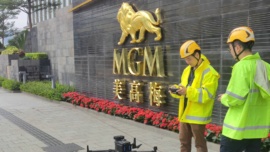The MSAR is part of the second stage of concentration for travel service provider Ctrip in its continual expansion and diversification drive, said group CEO Jane Jie Sun.
According to the her, the first stage of the expansion lies in the company’s core market and main focus, Mainland China, while the last of the three steps will be a further opening up of new markets in Asia including Japan, Korea and others in Southeast Asia.
The news comes from the Ctrip CEO’s interview with travel publication Skift.
The CEO took up the position in November, replacing Gao Xiang but continues in the same vein as her predecessor, who had previously expressed the group’s intention to target travel products and services. These include those in the MSAR, where the travel services company estimated that it had made MOP10 million (US$1.3 million) in sales last year.
The group’s local efforts focus on linking up with e-commerce operators to provide one-stop package offerings, linking local features to tourism consumption.
The most recent data from the Statistics and Census Service (DSEC) show that visitation to hotels and guesthouses by Mainland Chinese visitors to the MSAR in January went up 17.1 per cent year-on-year, hitting 679,000. Meanwhile, visitation by Mainland Chinese to the MSAR on package tours fell by 9 per cent year-on-year in the same month, to 402,000.
Customer base
According to data from the China Tourism Academy, the total number of outbound Chinese tourists from the Mainland last year hit 122 million, while their aggregate spending amounted to US$109.8 billion overseas.
It’s no surprise, then, that Ctrip, unlike rival travel services companies like Expedia, chooses to focus on its core customer group – Chinese travellers – in a two-tier strategy.
First, after the company’s acquisition of travel fare aggregator Skyscanner for US$1.74 billion, the company will focus on full-service packages for Chinese tourists abroad, something encouraged by a recent global opening up.
“Lots of countries have lifted their visa restrictions for Chinese customers so that’s why it’s a wonderful opportunity for us to explore the opportunity along with our customers,” said Sun, as cited by the publication.
“Our goal is that wherever our customer goes we will be able to help them by supplying them with the best inventory, the best price, best services,” she continues, explaining that “we want to make sure we start with China and Chinese customers because they have a language problem,” facilitating the pitching of service packages, from hotel to transportation and sightseeing.
According to the group’s fourth quarter financial results, the strategy seems to be working, with a 76 per cent year-on-year increase in net revenue to RMB5.1 billion (MOP5.9 billion/US$737.5 million), a 56 per cent increase in accommodation reservation revenues (to RMB1.8 billion) and transportation ticketing revenues for the same period up 97 per cent year-on-year.
Additionally the group saw its profits multiply 6.5 times year-on-year in the fourth quarter.
“I think the Ctrip brand is probably very well known within China,” notes the CEO, adding “hopefully, we’ll build a good brand in Asia […] Skyscanner is well known for their air products in Europe, so it’s two regions, different products.”
In the earnings call for the report, the CEO noted that “right now the contribution of international is about 10 to 20 per cent; going forward, we would like to grow it to anywhere from one-third, to 40 per cent or even mor.”
While this first wave of international expansion develops, the group will focus on second-tier and third-tier cities in the Mainland, of which it increased inventory by 80 per cent last year, notes the publication.
The move seeks to win over potential customers who would otherwise go to Alibaba or Airbnb in cities that formerly provided too-low margins to make them worthwhile.
























